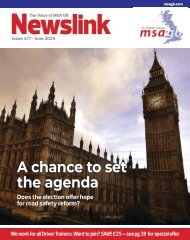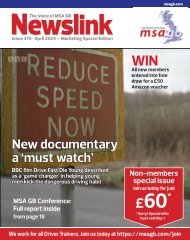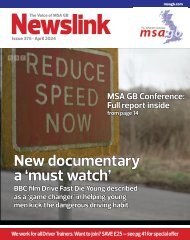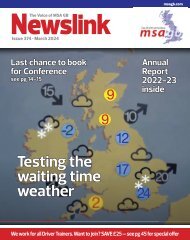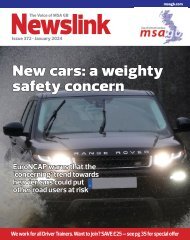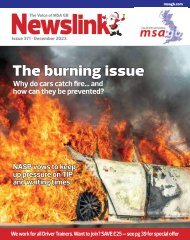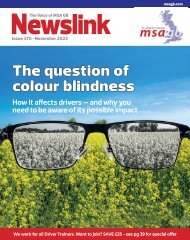MSA Newslink November 2021
Motor Schools Association, driver training and testing, road safety
Motor Schools Association, driver training and testing, road safety
Create successful ePaper yourself
Turn your PDF publications into a flip-book with our unique Google optimized e-Paper software.
News<br />
L-test changes: it was ever thus...<br />
Mike Yeomans continues his<br />
look back at major changes<br />
to the driving test, picking<br />
up the story in 1967<br />
1967: On May 10, The Road Safety<br />
Act 1967 paved the way for regulations<br />
covering the licensing and testing of HGV<br />
drivers. The Driving and Motor Licences<br />
Division began promoting safe driving<br />
through film and TV ’shorts.<br />
1968: The test fee was increased to<br />
£1 and 15 shillings (£1.75p).<br />
1969: Changes to the driving test from<br />
2 June 1969 included:<br />
• vehicles used must not have dual<br />
accelerator control unless this had been<br />
made inoperable<br />
• a separate driving licence group for<br />
automatic vehicles was introduced<br />
• candidates were required to produce<br />
their driving licence to the examiner at<br />
the test and sign the examiner’s<br />
attendance record – examiners could<br />
refuse to conduct a test if these<br />
requirements were not met<br />
The Vehicle and Driver Licences Act<br />
introduced new regulations from June 25<br />
1969, including a licence fee increase<br />
and the specification of vehicle groupings<br />
for the purposes of driving tests. An<br />
up-to-date scheme was introduced for<br />
licensing and testing new lorry drivers on<br />
4 August.<br />
The first official driving manual was<br />
published in <strong>November</strong> 1969. Called<br />
‘Driving - the Ministry of Transport<br />
Manual’, it was priced 12s 6d (62.5p).<br />
1970: All driving instructors now had<br />
to be officially registered. 3,500 people<br />
were prosecuted for driving on a forged<br />
licence or wrongfully attempting to obtain<br />
a licence.<br />
The new HGV test prompted a change<br />
in PSV testing. Previously, vehicle<br />
inspectors had carried out PSV driving<br />
tests: this was taken over by HGV<br />
qualified examiners.<br />
1972: The demand for driving tests<br />
rose by 20% in 1972, and 15% more in<br />
the following year, leading to a huge<br />
backlog of tests.<br />
The minimum age for riders of<br />
motorbikes over 50cc was raised from<br />
16 to 17 from December 16, 1972.<br />
1973: Computerised driving licences<br />
were issued from March 1, 1973, with<br />
green paper licences replacing the<br />
old-style red booklets. A full licence was<br />
still only valid for three years.<br />
1975: Candidates no longer have to<br />
demonstrate arm signals in the driving<br />
test from May 1975.<br />
1976: Full licences become valid until<br />
the age of 70 from January 1976.<br />
In July, the Stanmore examiner training<br />
school was relocated to Cardington,<br />
Bedfordshire. New L-test examiners had<br />
to undergo four weeks of training.<br />
1981: The government produced a<br />
three-point package of changes:<br />
• the maximum size of learner<br />
machines was reduced to 125cc<br />
• provisional motorcycling licence<br />
entitlement was limited to two years<br />
• a two-part motorcycle test was<br />
introduced with the intention of reducing<br />
accidents by steering learners to take<br />
training with approved organisations on<br />
suitable motorcycles. The first part of the<br />
test included basic off-road control exercises<br />
– usually conducted at LGV centres. The<br />
second part included on-road riding.<br />
1982: Provisional licences were extended<br />
until the age of 70 from October.<br />
1985: PSV driving tests became<br />
compulsory in March. Previously, Traffic<br />
Commissioners decided whether local<br />
applicants took the test.<br />
1988: Driving tests were now<br />
A new test category was created<br />
for a car with a large trailer<br />
(B+E)... road safety reasons<br />
cited for its introduction...<br />
‘‘‘‘<br />
conducted under the provisions of the<br />
Road Traffic Act 1988.<br />
1989: A new accompanied motorcycle<br />
test was introduced on October 1.<br />
Prompted by alarming accident figures,<br />
the old-style ‘part 2’ motorcycle test,<br />
where the examiner stood by the<br />
roadside, was replaced by the new, more<br />
demanding ‘pursuit test’. The examiner<br />
now follows the candidate on a<br />
motorcycle and maintains radio contact<br />
during the test.<br />
1990: The Driving Standards Agency<br />
(DSA) was created as an executive<br />
agency of the Department for Transport.<br />
DVLC became an executive agency of<br />
DfT and renamed the Driver and Vehicle<br />
Licensing Agency (DVLA).<br />
Provisional licence holders were<br />
prevented from carrying pillion<br />
passengers, even if the passenger is a full<br />
licence holder. Compulsory basic training<br />
(CBT) was introduced for all new learner<br />
riders of motorcycles and mopeds.<br />
From May 1, examiners gave<br />
candidates a brief explanation of faults<br />
committed during the L-test, plus advice<br />
on areas for improvement.<br />
Anyone accompanying a learner driver<br />
from October 1990 must be at least 21<br />
and must have held a driving licence for<br />
a minimum of three years.<br />
1995: The Pass Plus scheme was<br />
introduced in <strong>November</strong> to help newly<br />
qualified young drivers gain extra<br />
valuable driving experience.<br />
1996: A separate written theory test<br />
was introduced on July 1, replacing<br />
verbal questions on the Highway Code<br />
during the L-test. The theory test pass<br />
mark opens at 26/35 but was raised to<br />
30/35 on 1 October.<br />
1997: New licence categories added<br />
and tests for learners aged over 21 years<br />
riding larger motorcycles (Direct Access<br />
Scheme) and small motorcycles.<br />
New riders under 21 years restricted to<br />
machines of 125cc while learning. Once<br />
they pass the test, they were then<br />
restricted to riding machines of 25kw<br />
(33bhp) for two years.<br />
New licence and test changes on<br />
January 1, 1997 included:<br />
• a new test category was created for a<br />
car with large trailer (B+E)... road safety<br />
reasons are cited for its introduction.<br />
• licence categories and tests were<br />
introduced for Direct Access and small<br />
motorcycles.<br />
30<br />
NEWSLINK n NOVEMBER <strong>2021</strong>




